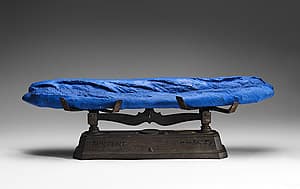

Man Ray
Learn morePain peint [Blue bread: favourite food for bluebirds] 1958
© Man Ray. ARS/Copyright Agency Purchased 1977
More detail | PermalinkConfusingly, a number of works by Man Ray are titled Pain peint (‘painted bread’). This is the first, made in 1958, and consists of two blue loaves of bread on a set of scales, the kind once common in grocery shops.[1] The loaves, lying as they do across both baskets, frustrate the scales’ balance. A second version of the work, made in 1960 for Cordier and Ekstrom, New York, carries three loaves in its panniers. The same title is also applied to single loaves of blue-coloured bread made by Man Ray in small editions either in polyurethane or plaster as required.[2] When Man Ray first made Pain peint in 1958 he used stale loaves of bread and simply covered them with blue paint but according to the artist, ‘mice ate through the paint and the stale baguette’, thus the loaves of this work are replacements made in plaster in 1964.[3]
Man Ray, who lived most of his life in Paris, worked and exhibited with many of the European Dadaists, and showed in the first Surrealist’s exhibition at Galerie Pierre in 1925. The impact of his collaborations with Marcel Duchamp, dating back to 1915 in New York, are readily apparent in his use of everyday objects, playful humour and element of surprise. Man Ray counted Gift 1921, a flat iron transformed with a row of nails, as his first Parisian Dada object and it remains his best-known work: just as Pain peint makes the weighing of substances impossible, the perverse and provocative Gift threatens destruction instead of pressed clothes.[4] A later work, Pain doré 1960 (‘golden bread’ or Pandora), likewise plays on words but this time uses an Italian-style bread.[5] Man Ray’s work, like that of many of his fellow Surrealists, was immensely influential both in Europe and internationally, especially in the inter-war and post-Second World War period when many artists sought refuge in the United States and elsewhere.
Although Man Ray claimed, around the time of moving to Paris in 1921, that his French was limited, or at least not sufficient to follow the more involved conversations of his peers, his enjoyment of the language is readily apparent in his work: he also identified Pain peint as ‘an onomatopoeic representation of the firemen’s motor-horns’ or a child’s imitation of that noise.[6] Because of the play on homophones in the French title, Man Ray did not want it literally translated for English catalogues or books. He therefore gave it the alternative English title and subtitle Blue bread: Favourite food for blue birds. One wonders what might be the effect of eating this ‘blue’ bread, either for mice or birds.
Lucina Ward[7]
[1] The first loaf is inscribed underneath ‘pain peint 59 / lere serie replique 1/4’ and the second loaf is inscribed ‘pain peint / lere serie replique — 2/4’.
[2] A series of single blue loaves was made in 1960 in painted polyurethane in an edition of nine. Another group was produced in 1964, in painted plaster in an edition of four, and yet another in 1966, again in polyurethane and an edition of nine. See http://www.sothebys.com/en/auctions/ecatalogue/2016/modernites-de-rodin-a-soulages-pf1716/lot.41.html, accessed 5 April 2018.
[3] Sanche de Gramont, ‘Remember Dada—Man Ray at 80’, New York Times Magazine, 6 September 1970, pp 6–7, 25–34.
[4] The original Gift disappeared in 1921. Man Ray remade it in 1952, 1958 and 1963, before he authorised the edition of nine in 1970, published by Luciano Anselmino for Galeria Il Fauno, Turin. The NGA’s Gift (1992.1587) is the prototype for this edition, and is marked ‘essai’ or proof on the handle.
[5] FIX NOTE: rf also sothebys.com, accessed 5 April 2018.
[6] Arturo Schwarz, Man Ray: The rigour of imagination, Thames and Hudson, London, 1977, p 199; rf also ‘You see when I painted a local bread blue, the idea of a title came to me almost immediately and almost automatically: in French “pain peint” painted bread, because it sounds also like the kids running down the street after a fire engine and imitating the sound of the sirens: “pain–pain–pain–pain–pain–pain”, you know.’ (Man Ray, BBC televised interview, 1972).
[7] Adapted and updated from Michael Lloyd and Michael Desmond, European and American paintings and sculptures 1870–1970 in the Australian National Gallery, Australian National Gallery, Canberra, 1992, pp 142–3.

